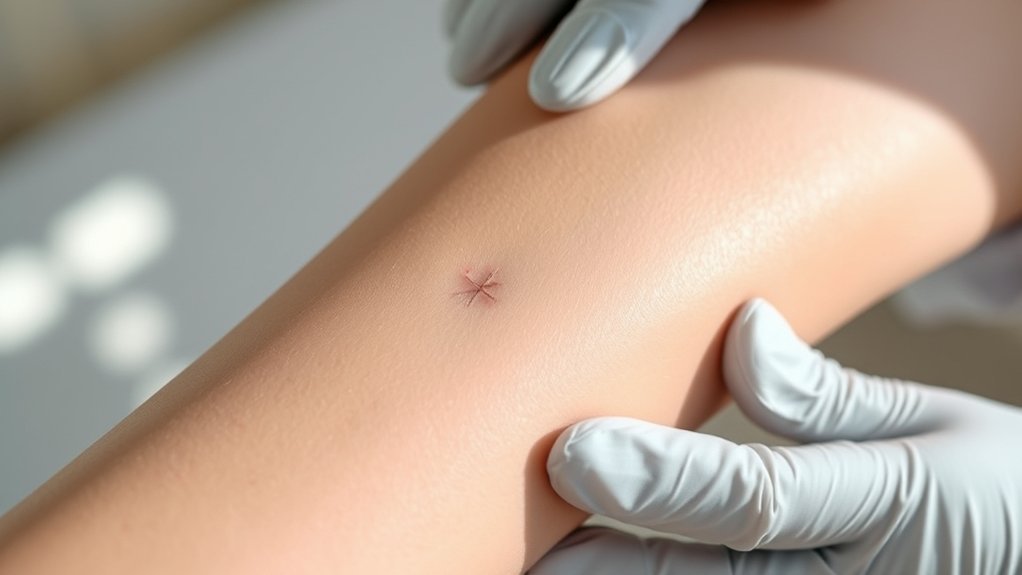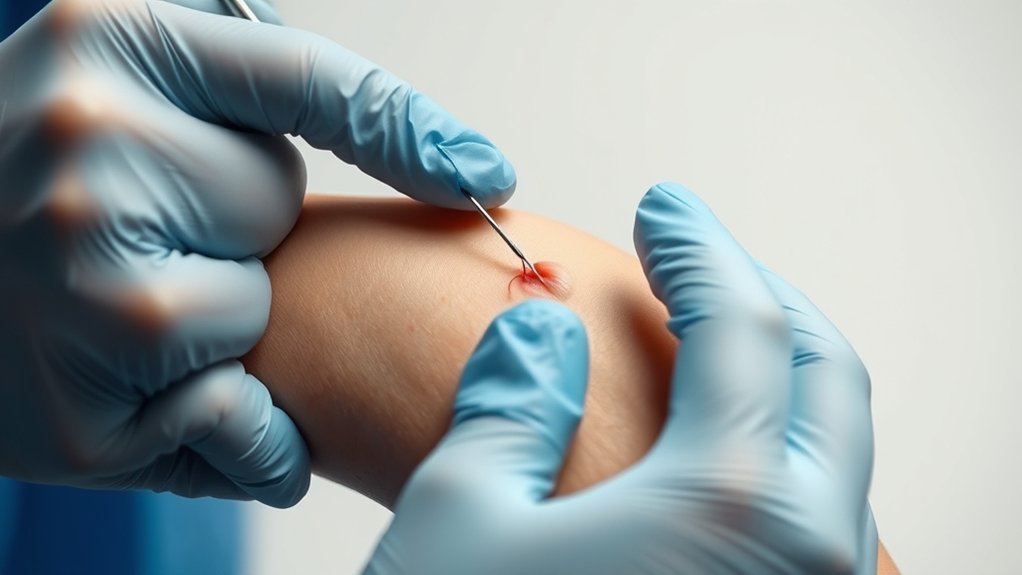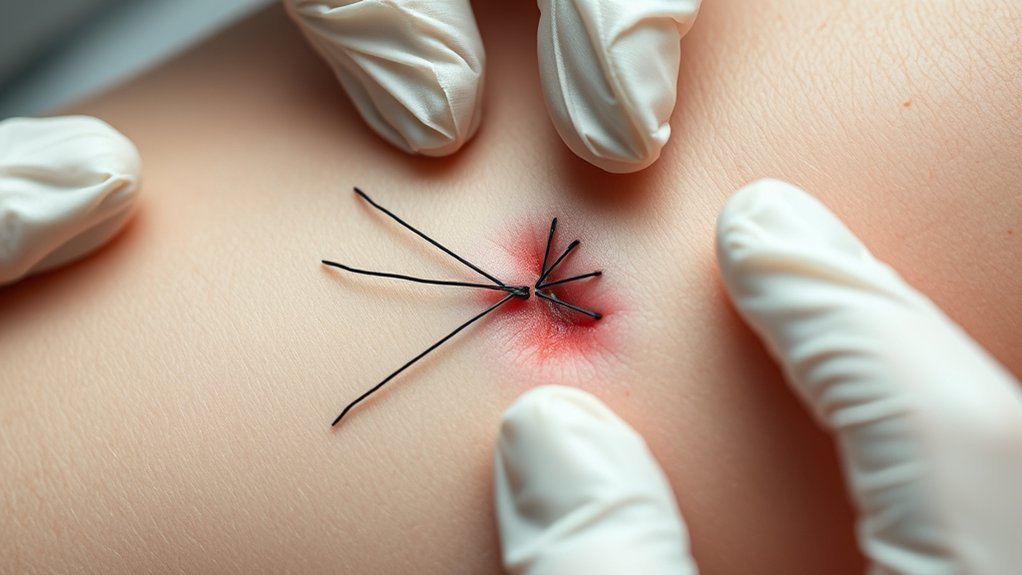Imagine your stitches as tiny soldiers, standing guard over your healing wound. Proper care is essential to guarantee they do their job effectively. There are key do’s and don’ts that can make a significant difference in your recovery. From keeping the area clean to recognizing signs of infection, each step matters. Understanding these guidelines can help you navigate the healing process smoothly, but what pitfalls should you avoid to guarantee the best outcome?
Understanding Stitches and Their Purpose
Stitches, or sutures, are essential tools in wound care that help hold the edges of cuts or surgical incisions together, promoting faster healing.
They play a vital role in wound closure, ensuring that your skin can heal properly.
You’ll encounter two main types of stitches: absorbable and non-absorbable.
Absorbable stitches dissolve naturally over time, while non-absorbable ones require removal by a health care provider.
The materials used for stitches vary, ranging from natural fibers like silk to synthetic options like nylon, depending on your specific wound and healing needs.
Stitches are made from diverse materials, including natural fibers like silk and synthetic options like nylon, tailored to your healing needs.
Typically, stitches stay in place for 3 to 14 days, with absorbable types dissolving within one to two weeks.
Understanding these basics can help you appreciate their importance in your recovery.
Essential Care Tips for Stitches
To guarantee your stitches heal properly, keep the area clean and dry for the first 24 to 48 hours.
Gently wash around the stitches daily, but avoid direct contact to prevent irritation.
Keep an eye on the site for any signs of infection, and reach out to a healthcare provider if you notice increased redness, swelling, or discharge.
Clean and Dry Area
Keeping the area around your stitches clean and dry is essential during the first 24 to 48 hours to help prevent infection. Follow these care instructions for ideal healing:
| Action | Details |
|---|---|
| Wash the area | Gently clean with cool water and mild soap 1-2 times daily, avoiding direct contact with stitches. |
| Dry the site | Dab the area with a clean towel, ensuring stitches aren’t disturbed. |
| Avoid soaking | Keep stitches out of baths or swimming pools until they’re fully healed or removed. |
Always replace any bandage over the stitches with a new clean one as directed by your healthcare provider. Keeping the wound clean and dry is critical for preventing infection and promoting healing.
Monitor for Infections
After ensuring the area around your stitches remains clean and dry, the next step involves closely monitoring the site for any signs of infection.
Regularly inspect the stitch site for increased redness, swelling, or discharge. If you notice any concerning changes, report them to your healthcare provider promptly.
It’s also essential to monitor for fever; if your temperature exceeds 100°F (37.7°C), this may indicate an infection that needs medical attention.
Be vigilant for unusual pain or tenderness around the stitched area, as this could signify an underlying issue.
Additionally, check for any oozing or pus from the wound. If the stitches become loose or break, contact your healthcare provider to assess the situation and determine if further action is needed.
Activities to Avoid During Healing
While you’re healing, it’s important to steer clear of certain activities that could jeopardize your recovery.
Avoid strenuous exercises and heavy lifting, as they can stress the stitches and reopen the wound.
Avoid heavy lifting and intense workouts to protect your stitches and ensure a smooth recovery.
Don’t swim, soak in hot tubs, or take long baths until your stitches are removed or cleared by your healthcare provider; these activities can introduce bacteria and increase the risk of infection.
Refrain from scratching or picking at the stitches or scabs, as this can complicate healing and lead to more scarring.
Limit exposure to dirt and bacteria by skipping gardening or contact sports.
Always follow specific activity restrictions from your healthcare provider to guarantee proper care and effective healing.
Recognizing Signs of Infection
When caring for your stitches, keep an eye out for signs of infection.
Increased redness, swelling, or pain around the stitch site can indicate trouble, as can any unusual discharge or odor.
If you notice these symptoms, it’s important to seek medical attention promptly. Additionally, personal insect repellents can help prevent insect bites that may lead to complications if they occur near your stitches.
Redness Around Stitches
Redness around your stitches can be a warning sign of infection, particularly if it spreads beyond the edges of the incision.
It’s essential to monitor the area for increased warmth, as this, along with swelling, can also indicate infection.
Pay attention to any yellow or green pus discharge from the stitch site; this is a common sign that requires medical evaluation.
If you notice redness accompanied by a fever over 100°F (37.7°C) or worsening symptoms, seek medical attention promptly.
Regularly inspect the sutured area for any signs of infection, and don’t hesitate to report your concerns to your healthcare provider.
Staying informed about these signs of infection promotes better recovery and health management.
Increased Pain or Swelling
Increased pain or swelling around your stitches can be a critical indicator of infection, especially if these symptoms worsen over time.
If you notice that the area feels warmer, or if tenderness increases, these may be warning signs you shouldn’t ignore.
Remember, if the swelling doesn’t subside and you experience a fever of 100°F (37.7°C) or higher within the first 48 hours post-surgery, it’s essential to take action.
While pain medicine might help alleviate discomfort, it won’t treat an underlying infection.
If you observe any troubling symptoms, contact a healthcare provider promptly.
Early intervention is key to preventing severe complications and ensuring a smoother recovery.
Your health is your priority, so don’t hesitate to seek assistance.
Unusual Discharge or Odor
How can you tell if your stitches are at risk for infection? Watch for unusual discharge from the wound, like thick, cloudy fluid, as this could indicate an infection.
If you notice a foul odor coming from the incision site, it’s vital to seek medical attention immediately. Other signs include increased redness beyond the edges of the wound or noticeable swelling.
If the area feels persistently warm and you develop a fever over 101°F (38.4°C), don’t hesitate to contact a healthcare professional.
Regularly monitor the suture area for any changes in discharge, odor, or appearance. Early detection and treatment of potential infections are essential for your recovery.
Minimizing Scarring After Stitch Removal

To minimize scarring after stitch removal, it’s important to focus on proper wound care and protection. Keeping your wound clean and dry is vital to prevent infections that can worsen scarring.
Here are some effective tips to help you:
- Use silicone gel or sheets to flatten and soften scars over time.
- Apply sunscreen on healing scars to prevent discoloration from UV exposure.
- Maintain a healthy diet rich in vitamins C and E to support your body’s healing process. Additionally, ensuring proper nutrition and wellness can significantly aid in the healing process.
Following your healthcare provider’s instructions and avoiding picking at the area also play significant roles in minimizing scarring.
With careful attention and these strategies, you can help guarantee your scars heal as best as possible after your stitches are removed.
When to Seek Medical Attention
While caring for your stitches, it’s crucial to know when to seek medical attention.
Understanding when to seek medical attention while caring for your stitches is essential for your recovery.
If you notice increased redness, swelling, or warmth around the stitch site, these may signal an infection. Contact your doctor or nurse if you see discharge or pus, as this could indicate a complication.
A fever of 100°F (37.7°C) or higher within 48 hours of getting stitches warrants immediate evaluation. Additionally, if you experience new numbness or tingling in the area, notify a healthcare professional, as this may suggest nerve involvement.
Finally, if bleeding doesn’t stop after applying direct pressure for 10 minutes, seek medical care promptly to prevent excessive blood loss. Your health is the priority, so don’t hesitate to reach out.
Follow-Up Care for Stitches
After addressing any concerns about potential complications, it’s important to focus on follow-up care for your stitches. Schedule follow-up appointments with your healthcare provider to monitor how your wound heals. During these visits, discuss any changes you’ve noticed, like increased redness or swelling.
Make certain to:
- Review care instructions to manage your incision site properly.
- Keep a record of your healing progress and any symptoms for your provider.
- Ask questions to guarantee you understand your recovery process.
These steps will help minimize the risk of complications and give you peace of mind.
Common Misconceptions About Stitches

Many people hold misconceptions about stitches that can affect their recovery. For instance, many believe stitches won’t leave a scar, but all sutures can lead to scarring; proper care can reduce their visibility.
Some think it’s safe to wet stitches right after placement, but you need to keep the area clean and dry for the first 24 hours to promote healing. Others assume stitches heal on their own, yet regular monitoring and following your healthcare provider’s instructions are essential to avoid complications.
Additionally, it’s a myth that all stitches dissolve; some require removal. Finally, don’t underestimate the importance of sun protection during healing, as it’s crucial for minimizing scar appearance after stitches are removed.
Frequently Asked Questions
What Should You Not Do After Getting Stitches?
After getting stitches, don’t soak the area, pick at the stitches, engage in strenuous activities, ignore signs of infection, or apply creams unless your healthcare provider specifically instructs you to do so.
Is It Better to Keep Stitches Covered or Uncovered?
It’s better to keep stitches covered initially to protect against infection. After 24 to 48 hours, if your healthcare provider allows, you can leave them uncovered to promote healing. Always monitor for signs of infection.
What Should You Avoid During Stitches?
“An ounce of prevention is worth a pound of cure.” Avoid soaking, scratching, strenuous activities, and applying creams on stitches. Keep the area clean and dry to guarantee proper healing and minimize complications.
What Helps Stitches Heal Faster?
To help stitches heal faster, keep the wound clean and dry, apply recommended ointments, eat a balanced diet rich in vitamins, avoid strenuous activities, and protect the area from sun exposure.
Conclusion
Taking care of your stitches is like nurturing a fragile seedling—gentle attention today blooms into a healthy tomorrow. By following the do’s and don’ts of stitch care, you protect your body’s healing process and reduce the risk of complications. As you watch your wound mend, remember that patience and vigilance are your allies. Stay alert for any signs of trouble, and don’t hesitate to reach out to your healthcare provider. Your recovery journey is worth every careful step.
